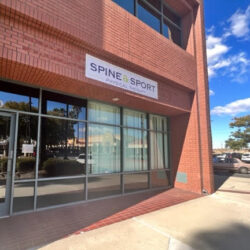The basics of physical therapy for post-surgery rehabilitation
- Because side effects of surgery can include reduced range of motion, flexibility and functionality, physical therapy is often recommended post op to ensure a full and speedy recovery.
- Starting rehab after surgery depends on the nature of the injury but may begin as early as the same day.
- Physical therapy is tailored to gradually improve strength, function and reduce pain while the body is healing – without the risk of tearing any sutures or injuring oneself.
- Spine & Sport Physical Therapy assess a patient’s surgical issues and develops a care plan, providing treatments to recover function and reduce pain.
Move forward, faster, fearlessly
What is post-surgery rehabilitation (physical rehabilitation)?
The body undergoes trauma during surgery and often requires physical rehabilitation afterward. Most patients will feel pain, swelling and inflammation as well as struggle to do typical tasks like walking up or down stairs. To get back to everyday life and activities, a doctor will recommend a rehabilitation program involving a variety of therapies, exercises and medications.
Physical therapy rehab is often a part of this treatment course as a way to regain strength and mobility while reducing pain. Physical therapy following surgery or a medical condition is a part of what is known as physical rehabilitation.
Almost any sort of surgical recovery can benefit from physical therapy, but the exact nature of rehab depends on the surgery performed and side effects. Broadly, this may include:
- Orthopaedic surgery may result in pain, reduced range of movement, balance and coordination problems.
- Cardiac/thoracic surgery can cause pain, breathing difficulties, reduced mobility, postural problems and reduced activity.
- Neurological surgery can include breathing difficulties, reduced mobility, loss of sensation, pain, balance issues and muscle weakness.
It’s important to start a post-surgery rehabilitation plan as soon as recommended by the care team. This may be a few days or a few hours, depending on the nature of the surgery and the patient’s health.
Risks of not completing post-surgery rehabilitation
It bears repeating that a rehab plan helps patients recover from surgery faster and prevent future injuries. Not starting or completing post-surgery rehabilitation can derail progress and result in permanent loss of function.
Why undergo post-op physical therapy
While the surgery is performed within hours, rehabilitation may take many months, potentially up to a year. Physical therapy can aid and even shorten recovery time. Physicians coordinate their post-operative protocols with Spine & Sport to ensure that patients achieve the optimal outcomes.
Overall, physical therapy after surgery helps:
- Reduce pain and swelling.
- Increase circulation.
- Obtain optimal range of motion.
- Restore strength.
- Improve balance and coordination.
- Speed up recovery.
- Minimize scar tissue.
What to expect from post-op physical rehabilitation therapy
Post-op care is coordinated with other healthcare professionals overseeing the patient to ensure that providers don’t just manage symptoms but also the underlying issue leading to surgery.
The physical therapist determines the exercises and treatments to focus on the areas of weakness and to maintain proper function as patients heal. We closely monitor patients throughout therapy and adjust the plan according to how they progress.
Depending on the type of surgery performed, the PT team may recommend a combination of modalities including ice and heat therapy, manual therapy, functional training, water aerobics or pool therapy, balance training, among others.
Physical therapy will almost always include stretching and exercise, while with the therapist and at home. For example, strengthening exercises will reinforce muscles and connective tissues that serve injured joints; corrective exercises can aid posture; pool therapy can take weight off painful joints while exercising critical muscles. All in all, post-surgery rehabilitation can greatly speed up healing and improve circulation and balance – reducing the likelihood of further pain and reinjury.
Some surgeries, such as a knee or hip replacement, may require occupational therapy. Therapists can teach patients how to walk and move properly and perform exercises to improve flexibility, strength and mobility.
Post-surgery rehab may be uncomfortable at times but should not be truly painful. Typically, those who don’t attend physical therapy as instructed accumulate a lot of scar tissue, which reduces mobility and increases pain. If a movement is too painful, whether in therapy or at home, treatments can be modified.
Everyone’s post-surgery physical therapy regimen is unique, as is the timeline for recovery. For some, it may only be a few weeks, while for others, it may be a year or more.
Get informed
[getpp func=”get_pages” include=”1263,32,28″ template=”blog” attributes=”title,image,excerpt,readmore”]
Spine & Sport clinics offering post-surgery rehabilitation near me
All of our clinics in Southern & Northern California offer physical therapy services for rehab.
 South San Diego County
South San Diego County Central San Diego County
Central San Diego County East San Diego County
East San Diego County North San Diego County
North San Diego County Orange County
Orange County Imperial County
Imperial County Coachella Valley
Coachella Valley Riverside County
Riverside County Ventura County
Ventura County Los Angeles County
Los Angeles County Northern California
Northern California